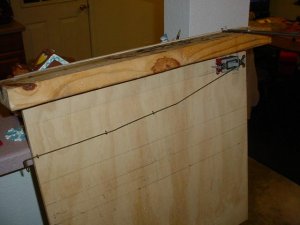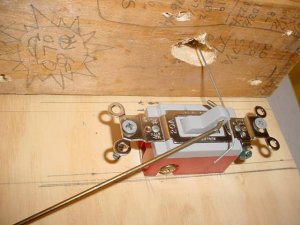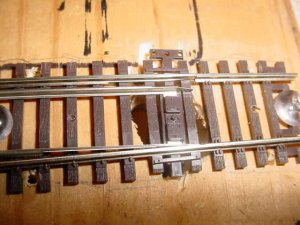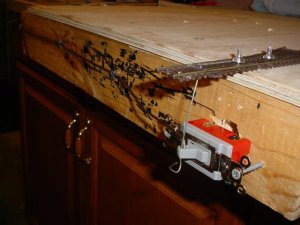Would you throw a turn-out using a mechanism like this?
This is an experimental version. I used a coat hanger for the push-pull rod, an everyday type electrical light switch for the mechanism, and a piece of tie wire to connect up to the turn-out. Perhaps a piece of small diameter spring steel or brass rod would work even better.
It actually operates fairly well. The push-rod would extend through the fascia and a cabinet drawer type knob could be epoxied on.
The switch contacts could be used for signals or indicators lights or something. Could be either a single pole single throw or a single pole double throw as needed.
What do yall think? oh... just so no one is confused by the pics... the side of the 2x4 represents the top of the layout and the turn-out is sitting on that, the piece of plywood is not the top of the benchwork, I was just using it to try out different angles of the pushrod, seeing just how far down I could go and still make the switch work.
P.S. I saw an idea similar to this on the internet and modified it using different stuff.
This is an experimental version. I used a coat hanger for the push-pull rod, an everyday type electrical light switch for the mechanism, and a piece of tie wire to connect up to the turn-out. Perhaps a piece of small diameter spring steel or brass rod would work even better.
It actually operates fairly well. The push-rod would extend through the fascia and a cabinet drawer type knob could be epoxied on.
The switch contacts could be used for signals or indicators lights or something. Could be either a single pole single throw or a single pole double throw as needed.
What do yall think? oh... just so no one is confused by the pics... the side of the 2x4 represents the top of the layout and the turn-out is sitting on that, the piece of plywood is not the top of the benchwork, I was just using it to try out different angles of the pushrod, seeing just how far down I could go and still make the switch work.
P.S. I saw an idea similar to this on the internet and modified it using different stuff.





